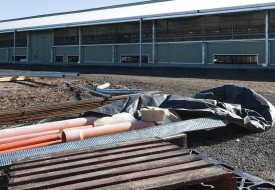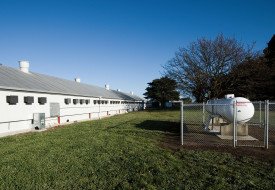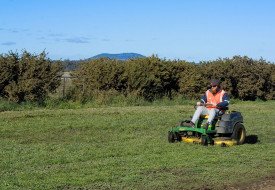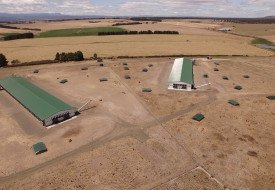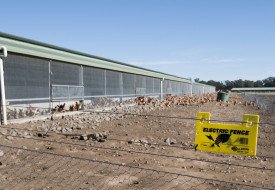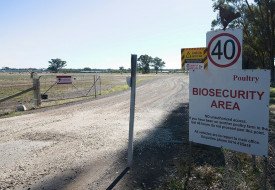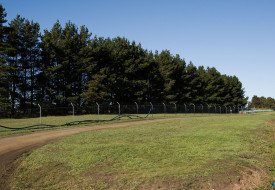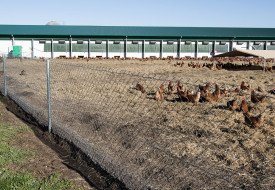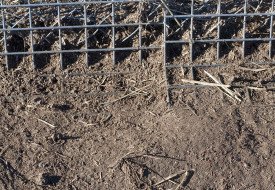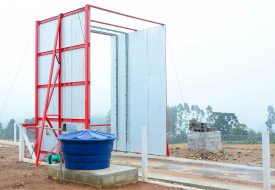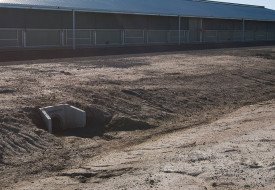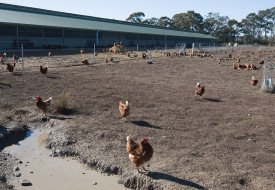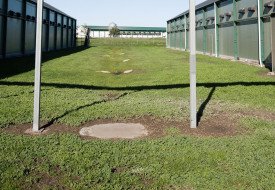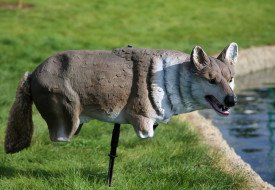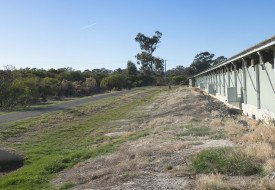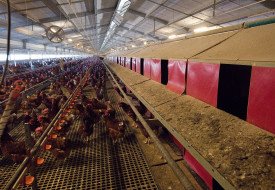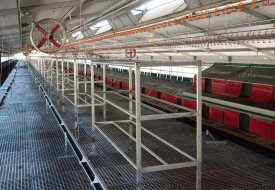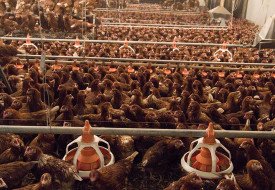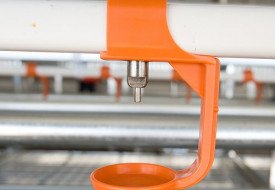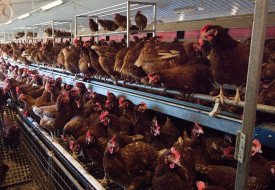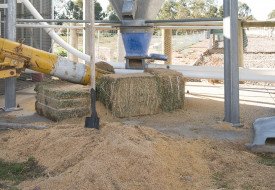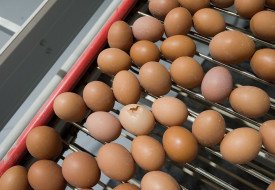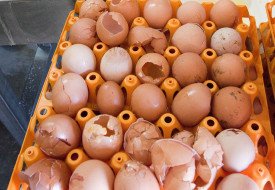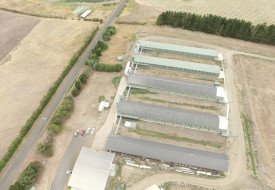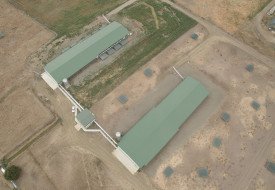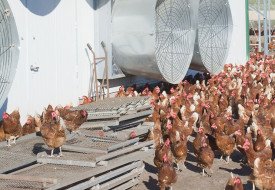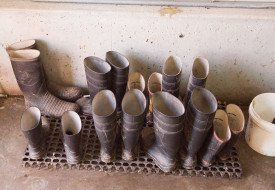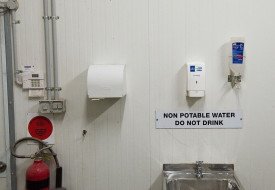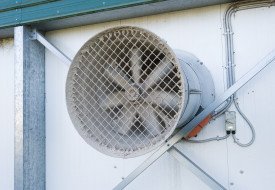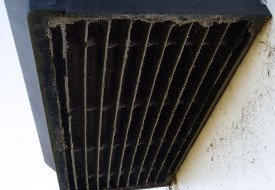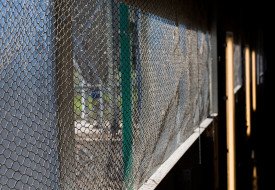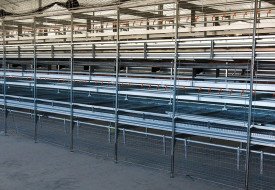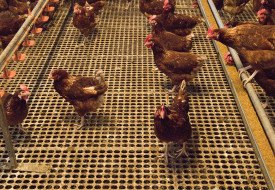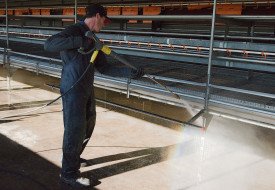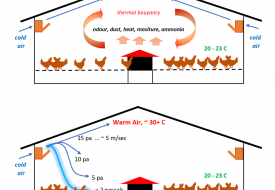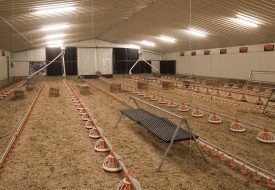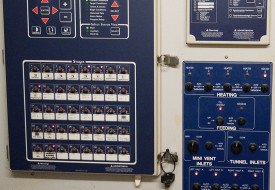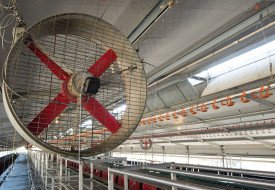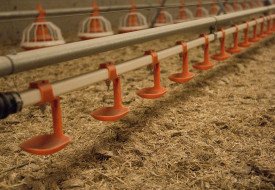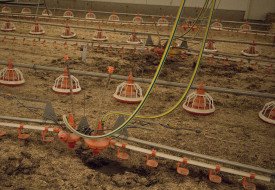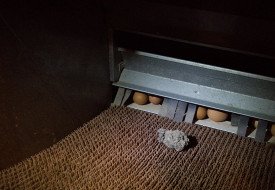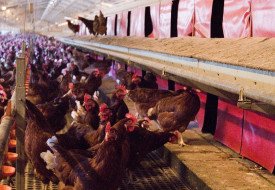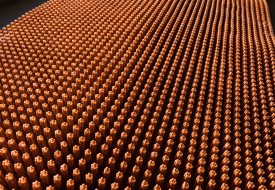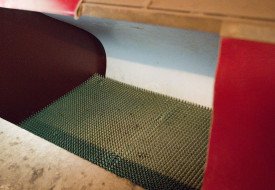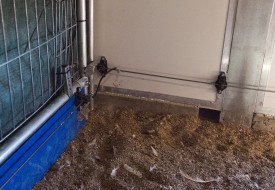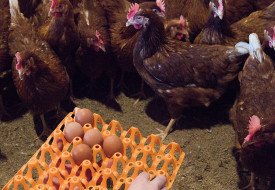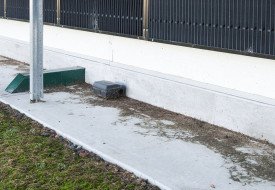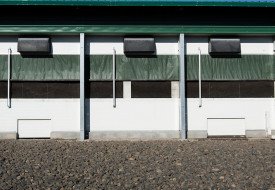Hen Housing & Equipment
Hen Housing & Equipment
This section identifies possible on farm risks in the design, layout and set up of poultry housing sites and equipment.
Housing Surrounds
Debris and vegetation around the housing
Ensure commercial poultry production areas are neat, tidy, free from debris and have a buffer zone with properly maintained natural vegetation to reduce the risks of access by potential Salmonella vectors, including wild birds, insects, rodents and other animals.
Each cage, barn and free range system is different, but all permanent facilities should be designed and maintained to prevent entry of wild birds and limit vermin access.
Good site management includes regular mowing of grass or removing vegetation in a 1.5 metre radius (minimum) around the poultry housing. Rocks may replace plants in this buffer zone.
Moving vegetation cover, spilt grains or other debris near the production facilities will reduce organic loads, insect breeding areas and availability of nutrients for disease and bacterial growth.
These key measures can limit coverage, shelter and breeding areas for disease carriers (especially rodents and wild animals) and reduce the chances of Salmonella entering facilities.
In free range systems, rodent control and maintaining minimal organic load around the immediate production area reduces Salmonella risks and reduces dust movement through the site.
It is more difficult to control wild bird entry in free range operations, but this can be addressed by using trees, shrubs and other amenities that are unattractive to them.
Perimeter fencing
A robust perimeter fence around properties or secure fencing around production areas is necessary to limit unwanted entry by land animals and people that can carry Salmonella. This will substantially reduce risks of infection in the environment, to hens and eggs.
Animals such as turkeys, domesticated and wild dogs, cats, foxes, wild and domesticated birds, other chickens or livestock on a property can be carriers of some types of Salmonella. The risks these animals pose to cage, barn and free range poultry operations increase when there is hen contact with faecal material from infected animals.
The main entrance to the egg production area should be capable of being locked or closed to vehicle traffic. It is recommended signage is used to clearly show the facility is a “Biosecure Area No Entry Unless Authorised” or similar wording.
It is important to direct all site visitors to contact the producer or operator before proceeding, including adding a telephone number or alternative directions to an office or house.
Farm staff and visitors should not enter the poultry site if they have had contact with hens from another property.
Adequate fencing can deter humans from entering production areas. This is important, as people can be a source of Salmonella infection to poultry and eggs if they have been infected by other people, other poultry operations, domestic birds, farm environments, laboratories and from overseas travel.
Fencing can also effectively separate free range production systems from any cage or barn facilities on a property and clearly defines a biosecure zone for the production area.
If the property has other livestock, the poultry production area must have a stock-proof fence. Nearby grazing is permitted only if there is separation by a stock-proof barrier.
Movement of all vehicles, equipment and machinery on the farm should be restricted to outside the poultry area perimeter fence. This includes for operations such as dead bird retrieval, waste removal, feed delivery and other deliveries.
If vehicle movement cannot be directly controlled, other management strategies can be used, including:
- Having designated vehicles and equipment for use inside the fence
- Allowing vehicle movement only one way in one day
- Installing a designated vehicle sanitising station
- Ensuring machinery, equipment or vehicles entering the property are clean.
Drainage around the shed
Design of drainage systems for barn, cage and free range egg production operations should focus on ensuring water can’t pool close to the site from rain, water used during shed clean-out or when there is any other overflow.
Bodies of stagnant and persistent water in the housing or free range areas can attract vermin and other animals, including wild birds and waterfowl, that can carry and potentially transmit Salmonella. Standing water can also attract insects that carry strains of the disease.
Other risks posed by stagnated water or mud around barn, cage or free range areas include:
- Proliferation of bacteria
- Bacteria contaminating eggs if hens lay into it (only free range)
- Transfer of mud into the housing that could contaminate feed, water and nests (only free range).
It is recommended any drainage or overflow from surrounding livestock pastures or holding areas on the property does not enter poultry enclosures, or areas that can be accessed by poultry (such as through fences). For a free range site, it may be necessary to use contours to limit run-off water from other parts of the property.
For all systems, a management plan should be implemented to avoid potential pot-holes or water pools forming after heavy rain.
If there are nearby water reservoirs, it is advised to reduce attractiveness to waterfowl (such as ducks) by:
- Eliminating irrigated grass
- Covering dams with nets
- Using an active duck repelling program.
Housing Equipment
Perches
If perches are used for egg production, these should be positioned to reduce the incidence of hens defecating on each other, into feed, water or nest areas.
It is recommended perches are designed with about 30 centimetres of space and distance in between. This allows a mature size hen to face in either direction and avoids the chances of defecation directly on to another hen perched below.
If hen nests or nest boxes are used, these should be designed to avoid birds perching on the edges and defecating into the nest.
Feed and water sources in the housing or free range area should be free from hen defecation material as this can contaminate these key production inputs. It also risks creating an environment for Salmonella and other bacteria to grow, especially if the faeces is moist.
Salmonella can persist in the feed. Research shows Salmonella appears to have specific genes that allow the pathogen to survive in the acidic environment of faeces.
Feed pans / troughs
Poultry feed systems must be closed and feed pans and troughs positioned to limit access by wild birds, rodents and other vermin.
This can help ensure hen feed sources in bulk silos and feed delivery systems are protected from access and contamination. Rodents and insects have been found to transmit Salmonella to hens through feed and drinking water.
Feed pans and troughs should be well separated from hen drinking water troughs to reduce risks of water coming into contact with feed. Drinking water systems need to be efficient and unable to leak, splash or pool with excess water.
In free range systems, feed pans and water troughs should be located inside the production sheds and covered to protect against adverse weather. There needs to be minimal opportunity for access by insects, rodents and wild birds.
In all types of production systems, hens shouldn't be able to perch above any feed pans or water troughs as faecal contamination in the feed and water risks spreading any Salmonella through a flock. Anti-perching wire may be used to exclude perching over troughs.
It is also recommended to place pans and troughs at a height (ideally feeder lip at hen back height) and design that limits feed spillage by hens during feeding, or through scratching. Hens should be unable to excessively flick feed onto the floor around the feeder, which can be one of the most faecally contaminated areas in the hen house.
Drinking water troughs should provide hens with a constant water supply to help manage any stress, as this can cause shedding of Salmonella. Water lines and attachments should be well maintained, clean and free from organic matter build-up.
It is important for hygiene and reducing contamination risk that any water or feed spills outside production areas are removed and fully cleaned without delay. This will prevent attraction of wild birds and vermin.
Compounding mechanical stress
Good management of cage, barn and free range poultry systems includes a thorough assessment of potential mechanical stresses to eggs throughout the whole production and through-chain process.
Mechanical stress can occur when an eggshell contacts another surface, such as:
- Other eggs
- Equipment
- Egg belts
The risk is fracturing may form in the eggshell, which can vary from being highly visible to undetectable even by automated detectors.
Visible cracks or fractures are considered to be a high risk for bacteria entry to the egg and it is illegal to sell cracked eggs under FSANZ.
Housing Layout
Hen housing orientation and layout
For cage and barn poultry production systems, the orientation and distance between hen housing facilities should be adequate to minimise potential Salmonella transmission and spread between flocks.
Salmonella can persist in dust, hen organic matter, faeces, feathers, dirt and other particles. These can move rapidly, depending on air, wind and ventilation conditions. This poses a risk as pathogens are being drawn into surrounding hen housings and require measures to minimise dust and debris levels.
To reduce potential disease entry and transmission in cage and barn facilities from dust and other materials, careful planning of the layout and design of the hen house is important.
The entrance should be via a clear footpath area that is kept free of debris and potential dust sources. It is advisable to have an area where boots are scraped before treatment in a boot dip that contains an effective disinfectant. The disinfectant should be used according to label instructions and changed regularly. It is vital this sanitising process thoroughly disinfects the boot soles.
Facilities for hand sanitation must also be placed at the entry of each shed.
In free range operations, there is a need for similar boot dip and hand sanitising procedures at the access point to minimise risks of possible introduction from off-site pathogens.
The design and maintenance of all poultry housing and free range areas should aim to prevent the entry of wild birds and limit access by vermin and other animals, as far as is practical.
If more than one commercially-produced avian species are kept in a single production area, which is not recommended, the different species must be housed and managed separately. In these operations, there needs to be adequate internal biosecurity arrangements for each species - as well as the overall property boundary biosecurity provisions for the entire site.
Inside cage, barn or free range areas, hen feeding systems should be closed where possible to ensure that feed in silos and other feed delivery systems is protected from access and contamination by wild birds and rodents.
If an operator weighs birds as part of the production system, weighing frames and scales should be isolated for use only in the one barn, cage or free range area. Facilities need to be available for contract service providers to clean and disinfect their equipment before entry.
Housing floors
For optimal hygiene and minimal risk of spreading Salmonella in barn and cage production systems, the flooring of the hen housing should be made of impervious material. Concrete is ideal.
Alternative options include using a flooring material able to be cleaned as easily and thoroughly as concrete, or creating a floor surface that is raised above the impervious surface. Any raised surface should be constructed with material that allows organic matter and dust to fall through, such as plastic slats.
In cage-free hen housing facilities, raised slatted surfaces reduce the amount of organic matter and dust that comes in contact with the hens. This debris penetrates the slats and falls to the floor below for fast and easy removal without disturbing the hens.
All types of hen housing flooring need to be cleaned regularly.
Housing ventilation
Ambient conditions in cage and barn poultry facilities have a big impact on Salmonella persistence, growth and transmission. Ensuring adequate ventilation in these areas is a key risk management tool.
Ventilation systems should create consistent airflow to reduce excess moisture and dry any wet faeces, which can be a reservoir for Salmonella. This bacteria does not grow well in a dry environment.
In cage-free hen houses, good ventilation can also limit hens spreading wet faeces by their movements and reduce the incidence of floor eggs coming into contact with wet faeces.
Egg in contact with wet faeces increases risks of internal egg content contamination, especially straight after lay.
If the internal temperature of the egg is higher than the temperature of the wet faeces, bacteria can be drawn into the egg internal contents. The cuticle, which can protect the shell from bacteria entry, takes about three minutes to harden after lay and this time lag exposes the shell to potential pathogen diffusion.
Ideally, hen housing facilities should be aligned to prevent the potential for cross-shed disease contamination from any forced flow ventilation systems. Sheds that are located next to each other should exhaust on the same side, intake on the same side and not draw exhaust straight into intakes.
Tunnel ventilation can be used to draw air from one end of the facility to flow through the shed to cool hens. This is particularly useful for multi-age poultry houses.
For all ventilation systems, the air source area needs to be minimally contaminated by other hens or hen housing outputs. Shed outputs into other sheds should be minimal.
Litter treatment and nest box placement
For barn and free range poultry production areas, it is important to maintain an acceptable quantity and quality of the hen litter condition.
Any wet spots in the litter, mainly caused by spills of drinking water or faeces, will also promote Salmonella growth and should be removed quickly and regularly. Hens can dig through this and spread any bacteria through the shed.
Management of litter and potential wet spots should focus on limiting potential proliferation of bacteria and reducing bacterial loads inside the hen housing.
If the cage or barn facility uses flooring made of part litter and part slats, it is important to use practices that reduce the incidence of hens transferring dirt, litter and mud into nest boxes.
Eggs laid in nest boxes should not have prolonged contact with dirt, litter or mud, as these can carry Salmonella. Nest boxes need regular maintenance and cleaning to minimise egg exposure to these materials.
Eggs laid on the housing floor are at high risk of bacterial contamination from dirt, dust, faeces and moisture. Minimising the number of eggs laid on the floor can be achieved by training hens to use nest boxes and discouraging laying elsewhere in the facility, such as outside, in dirt, mud or faeces.
Hen training starts by enticing them into the nests prior to initiation of lay. The hens need time to learn to use the nests and adapt to measures that prevent entry during non-lay periods, such as at night. Other tactics include:
- Minimising outside stimulation in the pre-lay and initial lay periods
- Electric fencing
- Stimulation placed in the boxes prior to lay
- Closing nest boxes at night
- Nest lights to encourage exploration.
Note: it is not advisable to leave nest lights on during peak laying periods during the day. Feed and drinking water are best located inside the hen housing to limit hens from laying eggs outside.
It is important to undertake regular monitoring, at least every 24 hours, to reduce or remove any faeces in the nest box and remove floor eggs.
Nest box material should not be too absorbent and needs to be clean before any new poultry batch entry. Good options for next box material include:
- Plastic mats
- Fake turf
- Sand
- Straw
- Shell grit
- Sawdust
- Wood shavings
- Carpet
- Steel mesh
Nest box material should be replaced or replenished when soiled or dirty, as debris and faeces harbour Salmonella.
Disposal of the nest box material and litter from barn or free range areas should not occur on adjoining land.
Fresh litter delivery and collection of manure and used litter is best carried out by transporters from reputable companies and not used for carting other used litter and manure. Trucks carrying manure and used litter should also not be used for back-loading grain without a prior thorough cleaning program and knowledge of all parties involved.
Drainage in the shed
Drainage needs to be adequate to ensure cleaning solution and water can’t pool or stagnate. This is conducive to fast and adequate drying of the floor area and reduces levels of potential dust and other organic matter contaminants that can harbour Salmonella.
In free range systems, bacteria can thrive where there is water or mud for extended periods.
In free range and barn systems, unwanted pooled water in the housing area presents a high bacteria contamination risk for hens laying floor eggs. Hens can also transfer mud around the house and contaminate feed, water and nesting areas.

 >
> 